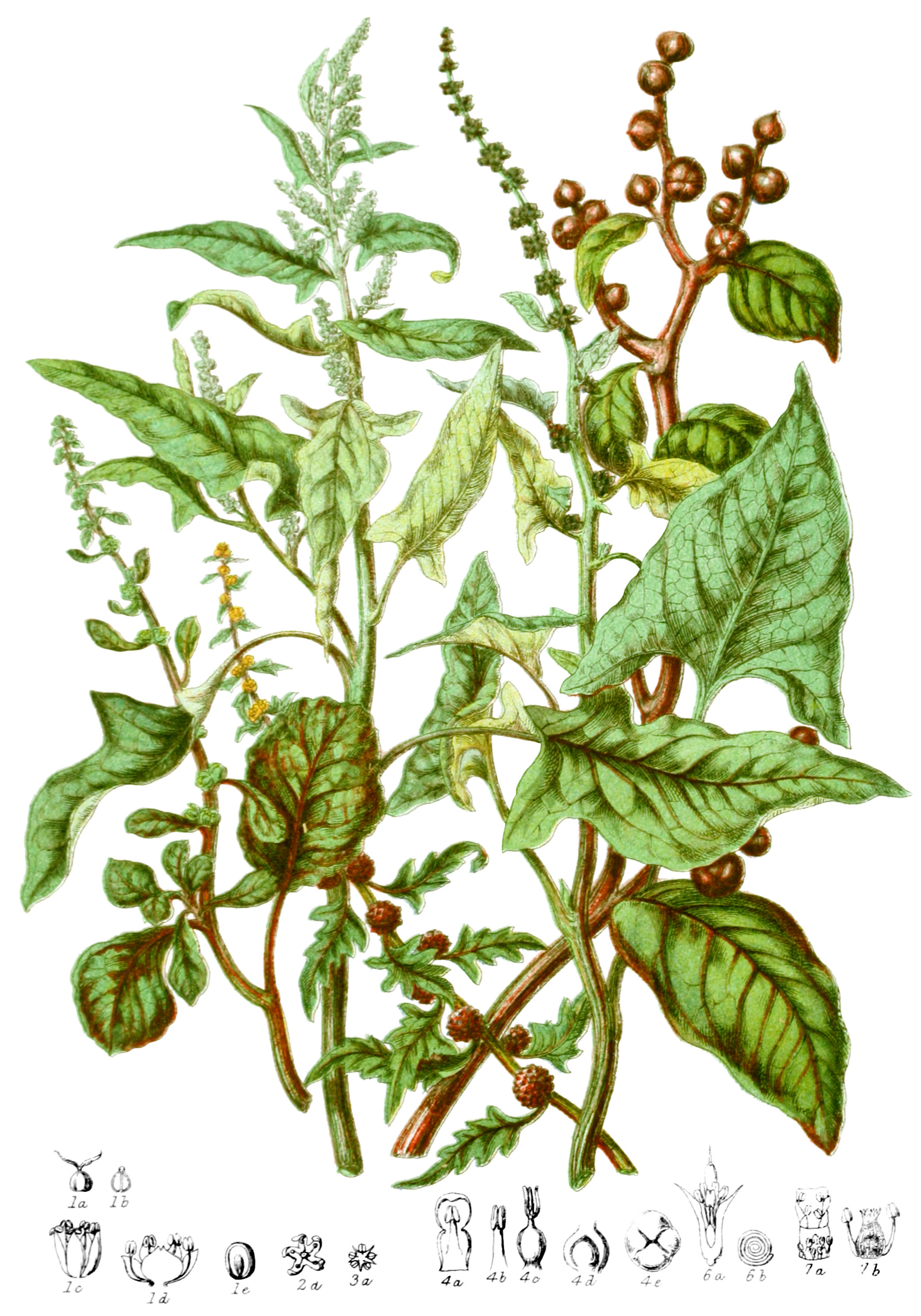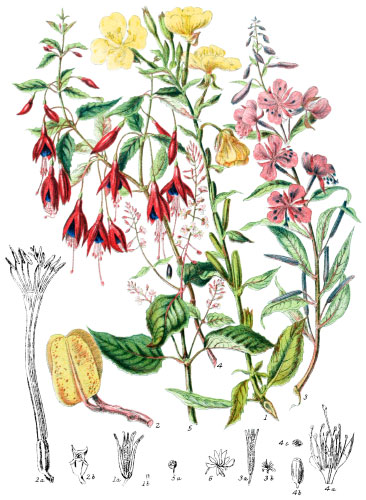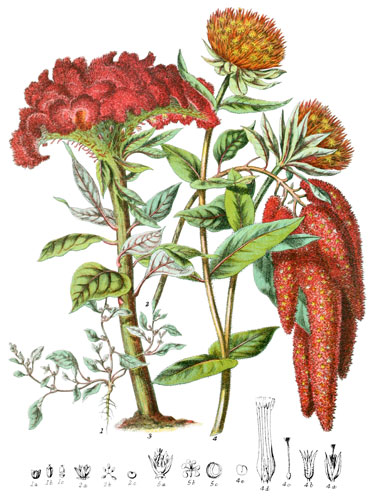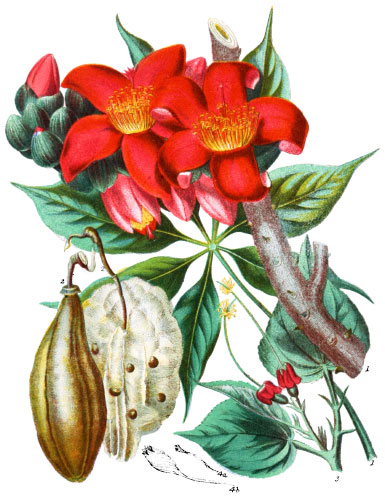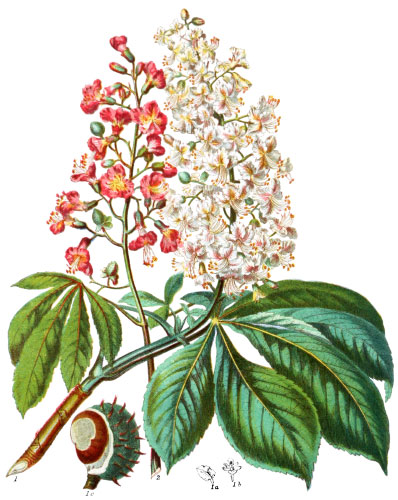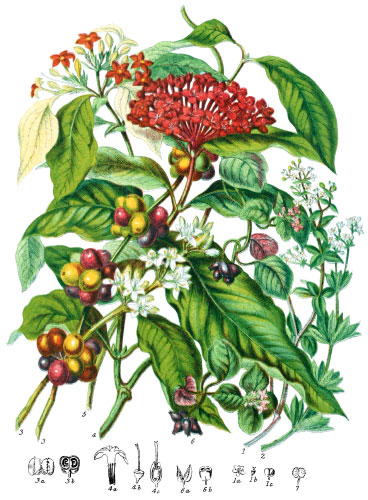Key characteristics
Under-shrubs and herbaceous plants, some of which are climbing; sometimes having jointed stalks. The leaves are alternate, occasionally opposite. The flowers are small, sometimes the stamens and pistil are in separate flowers. The calyx is deeply divided, sometimes rather tubular at the base; in Basella the sepals form two rows; the stamens are inserted into the base of the clayx, opposite its segments and equal to them in number, or fewer. The ovary is single, above he calyx, or sometimes adhering to the tube of the calyx. The styles are two or four, rarely single, the stigmas undivided. The fruit is membranous, sometimes a kind of berry is formed by the succulent calyx; the seed contains either a flat spiral embryo in albumen, or a conically spiral one without albumen.
This Tribe has affinity with Amarantaceæ and Phytolaccaceæ, but is distinguished by the number and position of the stamens.
Many of these plants contain soda, others sugar, in the root.
Select plants in this order
Not all plants listed are illustrated and not all plants illustrated are listed.
- Chenopodium, from the Greek for goose-foot, is a genus very frequent in Europe, usually on waste ground, or on heaps of rubbish, where C. bonus Henricus (1) is to be found. This species was formerly cultivated in gardens, and eaten as a vegetable; the mucilaginous leaves are still, in country places, thought good for healing slight wounds.
- C. olidum also affords wholesome food.
- C. maritimum may be preserved as a pickle; when burned it produces soda, like several other plants of this tribe.
- C. quinoa of Peru is one of the common eatable herbs of that country; its seeds contain wholesome farinaceous matter.
- The shape of the leaf varies in different species, but they are all more or less of a triangular form; and that of C. bonus Henricus sufficiently justifies the choice of the generic name, resembling as it so nearly does the webbed foot of a goose.
- Beta (2), from the old Celtic word for red, has long yielded a good supply of nutritious food in its root, enlarged by cultivation, but is of late years become greater importance to man for the sugar obtained from two species.
- B. vulgaris of the south of Europe is the common Beet-radish, eaten both raw and cooked, used as a pickle, and is a substitute for coffee, now affording excellent sugar from the root; a find varnish may also be made from it.
- B. cicla is extensively grown in Germany, France, and Switzerland, the large leaves are used for soups.
- B. maritima (2) is a native of many parts of our south coast; its succulent nature renders it eatable as a herb, but the root is small, black without, pale within.
- Although the power of manufacturing sugar in so northern a country as France is considered of great value, yet the most important use of Beta is in the enormous root of Mangel-wurzel, as winter food for cattle.
- Spinacia (3) has the stamens and pistil in separate flowers; it has been a constant herb in English gardens for nearly three centuries; being very hardy, it is sown in the early spring, and affords a plentiful supply of its leaves, which have a pleasant sub-acid flavour.
- Basella (4) is the name of the plant in Malabar; it is much cultivated in the East Indies and China, and is also amongst the various vegetables which the French esteem and use more abundantly than the English.
- B. tuberosa of Quito has a large fleshy root.
- Blitum (5) is said to derive its name from the Celtic for insipid; the calyx enlarges and becomes succulent, enclosing the seeds, the whole cluster having at least the aspect of a strawberry.
- Salsola Kali is one of the valuable plants yielding in its ashes a large supply of soda; it grows on the sea-shore of temperate countries, and is easily recognized by its prickly-pointed leaves and three spiny bracts of the flowers (6).*
- S. soda abounds on the coasts of Spain, and forms barilla.
- S. sativa yields the best soda, now very extensively used in the manufacture of glass and soap, and for a variety of other purposes. The name Salicornia denotes its saline nature and horned calyx, which enlarges as the seed ripens, forming a covering to the seed-vessel.
- S. herbacea (7)† is common on the river shores of our east coast, where it is known as marsh Samphire, and made into a pickle.
- The silvery grey Atriplex is found throughout Europe, in salt marshes, on mud shores, on heaps of rubbish, and other rough places.
- One species of this apparently mean and despicable genus affords wholesome food; A. hortensis is cultivated extensively in gardens around Paris.
- Acnida cannabina is the Virginian hemp of N. America.
- Thelygonum cynocrambe abounds in slender saline crystals; it has medicinal propreties, and is also occasionally eaten.
Locations
This Tribe inhabits waste places in all parts of the world, most abundant in Temperate regions, frequent in salt marshes. Basella belongs to the Tropics.
Legend
- Chenopodium bonus Henricus, Goosefoot, or Mercury. England.
- Ovary and Styles.
- Seed.
- Flower of C. album.
- Section.
- Section of Seed.
- Beta maritima, Sea Beet. Shores, England.
- Flower.
- Spinacia oleracea, Spinage. South Europe.
- Stamen flower.
- Basella rubra. East Indies.
- Sepal and Stamen.
- Stamen.
- Ovary and Styles.
- Section of Ovary.
- Fruit.
- Blitum virgatum, Strawberry Blite. South Europe.
-
- Flower of Salsola Kali.
- Spiral embryo.
-
- Spike of Salicornia herbacea.
- Flower, magnified.
- Original illustration did not include lables for 1, 2, 3, 4, or 5.
- *6 was mentioned in the original description but only 6a and 6b were illustrated.
- †7 was mentioned in the original description but only 7a and 7b were illustrated.
Explore more
Posters
Decorate your walls with colorful detailed posters based on Elizabeth Twining’s beautiful two-volume set from 1868.
Puzzles
Challenge yourself or someone else to assemble a puzzle of all 160 botanical illustrations.
